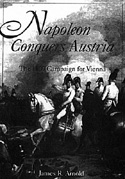 Author: James R. Arnold
Author: James R. Arnold
Pages: 265
Illustrations: 19 black and white plates (3 portraits, 4 photographs of terrain, 12 paintings of battle scenes).
Maps: 13 (one strategic showing theater of operations, ten grand-tactical with divisions and corps noted, and two tactical).
Footnotes: 418 notes (some annotated).
Appendices: 2 ( orders of battle for Aspern-Essling and Wagram showing regiments and batteries).
Bibliography: 9 museums and archives noted, specific cartons at Vincennes holding original French documents, 75 primary sources, and 83 secondary sources.
Index: 103 entries in 3 pages
Publisher: Praeger Publications (imprint of Greenwood Publishing Group, Westport, Connecticut)
ISBN: 0-275-94694-0
Price: $49.95
Summary: An impressive account of the second half of Napoleon's 1809 campaign along the Danube. In addition to providing the military and diplomatic context, the book fascinatingly details the battles of Ebelsberg, Aspern-Essling (Napoleon's first defeat as Emperor) and Wagram.
Arnold's Napoleon Conquers Austria (NCA) is a sequel to his Crisis on the Danube (published in 1990 by Paragon Press). Between them, these two books cover all the major military elements, and most of the political aspects, of the 1809 campaign in Austria. Crisis on the Danube ended with the Austrians in full retreat after the opening battles of Eckmuhl and Ratisbonne. Napoleon Conquers Austria picks up the story at that point and carries it through the bloody battles that followed, ending with the armistice at Znaim.
Napoleon Conquers Austria was written to stand alone, however, and repeats much of the discussion of the opposing national goals and comparisons of the French and Austrian military systems that were addressed in the first book. However, Arnold does this in a far more interesting and informative manner than in the first work. Perhaps it shows Arnold's growth as an author, or maybe just my own preferences, but his mix of anecdote, organization, tactics, and doctrine in NCA reads far better than his earlier "musket counting" approach. My only complaint about the background on the opposing armies is that there is almost thirteen pages on the French and less than six on the Austrians. A more balanced approach might have been possible by including some of the traditions of the Austrian regiments as he does for the French Imperial Guard.
Most of the book's ten chapters are devoted to descriptions of the three principle battles, Ebelsberg, Aspern-Essling and Wagram. The best elements of this book are Arnold's battle accounts [see featured excerpt on Aspernin this issue] These sections are very well-written and vivid. Arnold combines inputs from a number of sources into a seamless narrative, rather than retelling the battles over and over from different viewpoints. Most impressively, the battle accounts include more from the Austrian viewpoint than any previous accounts in English.
If this book has any flaws they lie in three areas. First, the maps are unworthy of the text. Many of the units named are not shown on the maps, nor are some key areas of the fighting. Second, the Orders of Battle in the Appendices do not show unit strengths. Given that strength returns are readily available, their absence weakens the effort.
Third and lastly, the concluding chapter ("An End to Glory") paints the battle of Wagram as a watershed in warfare, as "the last campaign where cavalry shock action had decisive tactical importance." Although he acknowledges that "there would be one more field on which cavalry had close to the same tactical impact: Borodino," Arnold claims that "all contestants in subsequent campaigns involving continental armies thereafter relegated cavalry to secondary importance."
This is, to say the least, a very controversial generalization. Several battles after 1809, including Katzbach in 1813 and Vauchamps in 1814, were decisively won by the cavalry. Arnold's final chapter may cause some to discredit an otherwise excellent work.
Despite these imperfections, the book's virtues are many. For anyone interested in the 1809 campaign, this is an indispensable book. [Scott Bowden's book Armies on the Danube 1809 is recommended as a reference for orders of battle and maps to complement a reading of Arnold's book.]
James Arnold has written a first-rate and thorough account of the 1809 campaign. Readers will no doubt appreciate the mixture of tactical detail and sweeping narrative that combine to provide a riveting military history.
Other Book Reviews:
-
La Grande Armee by Georges Blond
On The Napoleonic Wars by David Chandler
Back to Table of Contents -- Napoleon #3
© Copyright 1996 by Emperor's Press.
This article appears in MagWeb (Magazine Web) on the Internet World Wide Web.
The full text and graphics from other military history magazines and gaming magazines are available at http://www.magweb.com